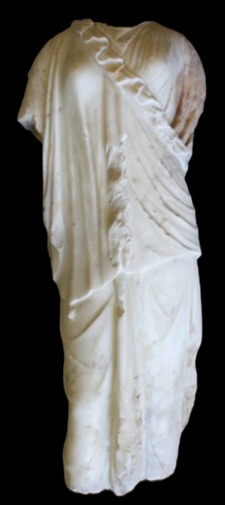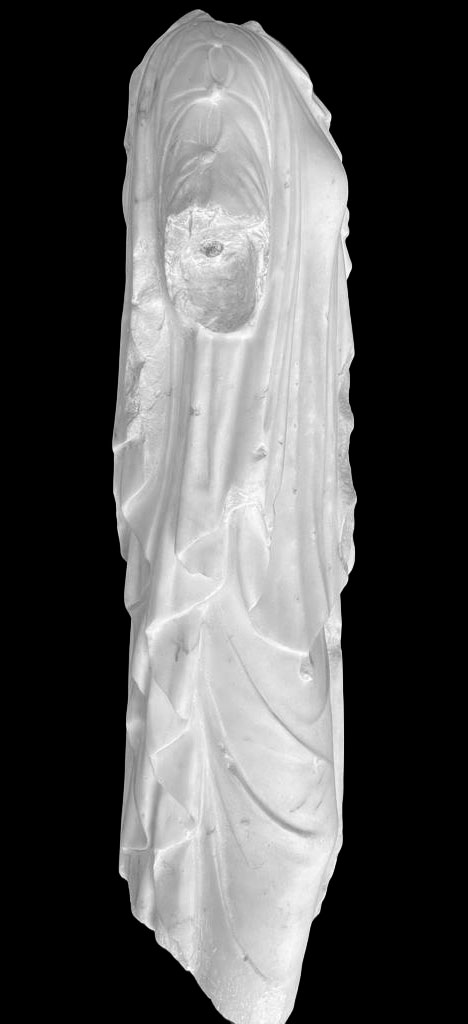Title
Archaising female draped figure
Content
I.D. no: 21095
Dimensions: Max. H. 88 cm; Max. W. 33 cm; Max. D. 22 cm.
Material: Very fine-grain white marble with plenty of long, continuous or broken grey-black lines.
Provenance: Unknown
Current location: National Museum of Archaeology, Reserve Collection
Condition:
Headless, with surviving hollow between the shoulders for insertion of a separately worked head. Missing are the left arm and the right forearm, both of which were worked separately and joined via metallic dowels, as well as both lower legs from mid-shin down. The original polished surface of the marble is generally well preserved, apart from scattered chipped crests of drapery folds. Black and yellow stains on and around the large break of the left shoulder.
A largish circular hole on the bottom surface is probably modern, made for fixing the statue on a base.
Description:
The figure takes up a slightly sinuous posture and stands on its left leg, releasing its right one to bend the knee in an effort to step forward. It wears a heavy-looking chiton buttoned on both shoulders and reaching down to the feet forming a thick, column-like fold in the middle, between the legs. Besides this and another fold hanging loosely down beside the left leg, this garment shows a few shallow creases but generally follows and brings out the shape of the legs underneath it. The upper body is covered also by a mantle that spreads out from the right shoulder to cover the right breast and the rest of the upper part of the body down to just below the hips. The mantle is characterised by three folds: a middle one starting from between the breasts and thickening down to overlap that of the chiton; another fold starts from between the right breast and shoulder and thickens down rigidly to the right hip where it ends with a small hanging tassel; the third is the most intriguing, crossing diagonally from the right shoulder to below the left armpit to reappear following the same direction at the back. It consists of a thick protruding and voluminous fold, with its meandering edge recalling the stylized ones of its Archaic forebears, the Athenian acropolis korai.
Discussion:
It is, indeed, this last feature that provides this statue with its archaising character. The contrast between the rather rigid mechanical treatment of the drapery and the relaxed, sinuous posture of the statue indicates that it is a Greco-Roman adaptation of the Archaic female korai of the Ionian type. The Archaic prototypes from which the Hellenistic ancestor of our statue derived its inspiration, through various intermediary stages, like the Caryatids of the Erechtheion, were probably such korai as the Acropolis nos 674 and 684,[1] that had been interred during the Persian occupation of 480 BC. Obviously missing in the Valletta statue are the typical stylized hair locks overlapping the shoulders and chest.
There exist many other archaistic draped female statues of the Hellenistic-Roman period that reproduce selective elements of their Archaic prototypes with varying degrees of fidelity. Similar to the Valletta one, with respect to the pattern of the drapery are the statuette of ‘Isis’ in the Museo del Prado;[2] two others of ‘Nemesis’ in Bucharest;[3] and a statue of ‘Tyche (?)’ in Cyrene.[4] Less rigid in the design of the folds of drapery, but equally inspired by the Archaic korai are the Caryatids from the theatre of Miletus.[5] Similar in the relaxed posture, but with a more fussy, crispy and lively drapery, is another statue in Madrid.[6]
In view of the Archaising elements manifested by the Caryatid maidens decorating the Canopus of Hadrian’s villa in Tivoli, it is tempting to see in it a Roman copy of an eclectic archaising prototype created in Hellenistic times, and insert it within the Hadrianic revival of the popularity of that fashion.[7] The possibility of a representation of a priestess is not to be excluded.
Bibliography: (previous publications of item): Bonanno. 1971: 192-95.
[1]Richter 1968: 81-82, 101, nos 121, 127, 182, figs 411-14, 578-82. See also the more exhaustive work by Karakasi (2003, also with colour plates and previous bibliography).
[2]Blanco Freijeiro 1957: 54, no. 63E, pl. 32; Schröder & Witte 2004: 401-03, Cat. no.189 (‘Estatua romana, 20 a.C-20 d.C.’).
[3]Bordenache 1969: 54-55, no. 91, pl. 41.
[4]Paribeni 1959: 152, no 443, pl. 191.
[5]Linfert 1976: 22, nos 8-11, pl. 2.
[6]García y Bellido 1949: 160-61, no. 172, pl. 130. See also Lippold 1956: 253-54, no. 28, pl. 112.
[7]For the archaistic, or archaising, style in Greek art, see G. Becatti 1958, s.v. Arcaistico, stile, and Arcaizzante, stile, in E.A.A. 1: 537-540, with previous bibliography.




